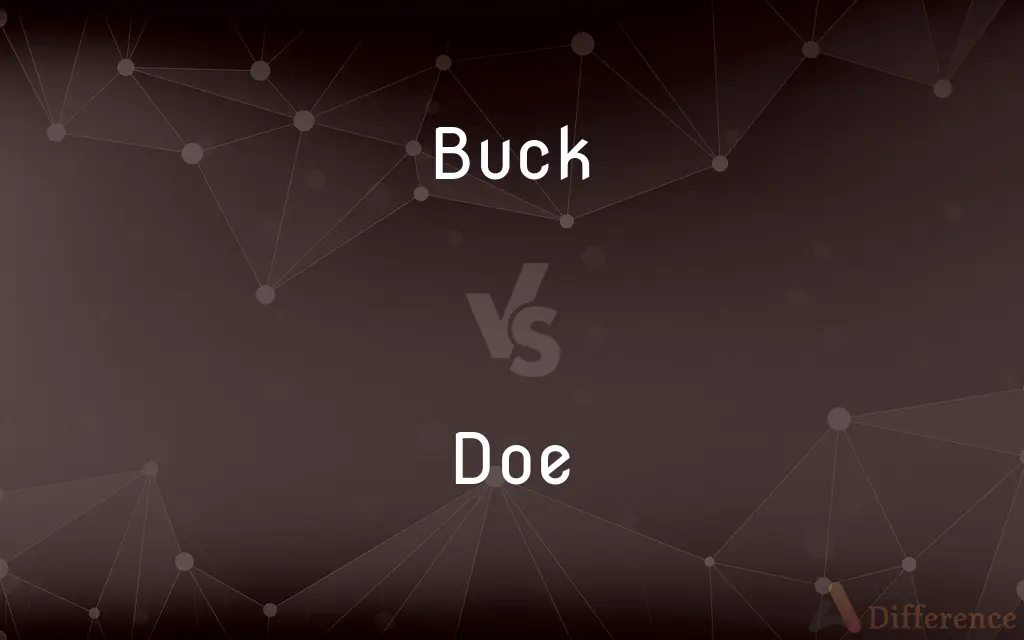Buck vs. Doe — What's the Difference?
By Tayyaba Rehman & Maham Liaqat — Updated on March 24, 2024
A buck is a male deer, notable for its antlers, while a doe is a female deer, typically without antlers.

Difference Between Buck and Doe
Table of Contents
ADVERTISEMENT
Key Differences
Bucks, male members of deer species, are characterized by their antlers, which they shed and regrow annually. Does, the female counterparts, usually lack antlers and are often smaller than bucks. The presence of antlers is a primary physical distinction, used during mating seasons as a display of strength and to compete for mates.
Bucks tend to be more solitary or move in smaller, male-only groups outside of the mating season. Does, however, are more likely to form larger groups, often seen with fawns or other does, which helps in providing protection and teaching the young. This social structure is pivotal for the survival and upbringing of offspring.
During mating seasons, bucks show more aggressive behavior, using their antlers in fights for dominance and the right to mate with does. In contrast, does focus on nurturing and protecting their fawns, showcasing the distinct roles each gender plays in the reproductive cycle and survival of their species.
The physical size and weight of bucks generally surpass those of does, reflecting their roles in competing for mates and defending territory. Does, being typically smaller, are more focused on evasion and camouflage, especially when caring for their young.
Understanding the differences between bucks and does is essential for wildlife management, hunting regulations, and ecological studies. These distinctions help in making informed decisions regarding population control, habitat conservation, and understanding deer behavior and ecology.
ADVERTISEMENT
Comparison Chart
Physical Trait
Possesses antlers, which are shed and regrown annually.
Typically lacks antlers.
Size & Weight
Generally larger and heavier than does.
Smaller and lighter compared to bucks.
Social Behavior
More solitary or in small, male-only groups outside the mating season.
Often found in larger groups, especially with fawns or other does.
Reproductive Role
Shows aggressive behavior during mating season for dominance.
Focuses on nurturing and protecting fawns.
Behavior Pattern
Uses antlers to compete for mates and defend territory.
More focused on evasion and camouflage, especially when with young.
Role in Ecology
Key for maintaining genetic diversity and population control.
Essential for the survival and upbringing of offspring.
Compare with Definitions
Buck
Known for their solitary nature outside mating seasons.
The solitary buck was spotted at the edge of the forest.
Doe
Focuses on nurturing and protecting their young.
The doe led her fawns away from danger with quick agility.
Buck
A mature male deer, distinguished by its antlers.
The buck led the herd with its impressive antlers.
Doe
Often forms larger social groups for protection.
A group of does and fawns moved through the forest together.
Buck
Bucks engage in antler displays and fights during mating seasons.
The bucks clashed antlers in a display of dominance.
Doe
The term can apply to females of other species, like rabbits.
A doe rabbit is responsible for nesting and caring for the young.
Buck
They are integral to deer population dynamics.
Bucks play a crucial role in maintaining the deer population’s genetic diversity.
Doe
Essential for the survival and education of offspring.
Does teach their fawns essential survival skills.
Buck
The term used for male members of other species, like rabbits.
A buck rabbit can be identified by its size.
Doe
A mature female deer, usually antlerless.
The doe was seen grazing in the meadow with her fawns.
Buck
A male deer.
Doe
A female deer, especially a female roe, fallow deer, or reindeer.
Buck
The male of various other mammals, such as antelopes, kangaroos, mice, or rabbits.
Doe
A female deer.
Buck
Antelope considered as a group
A herd of buck.
Doe
The female of various other mammals, such as antelopes, kangaroos, mice, or rabbits.
Buck
A robust or high-spirited young man.
Doe
A female deer; also used of similar animals such as antelope, (less commonly goat as nanny is also used).
Buck
A fop.
Doe
A female rabbit.
Buck
(Offensive) A Native American or black man.
Doe
A female hare.
Buck
An act or instance of bucking
A horse that unseated its rider on the first buck.
Doe
A female squirrel.
Buck
Buckskin.
Doe
A female kangaroo.
Buck
Bucks Buckskin breeches or shoes.
Doe
A female deer or antelope; specifically, the female of the fallow deer, of which the male is called a buck. Also applied to the female of other animals, as the rabbit. See the Note under Buck.
Buck
A sawhorse or sawbuck.
Doe
The federal department responsible for maintaining a national energy policy of the United States; created in 1977
Buck
A leather-covered frame used for gymnastic vaulting.
Doe
Mature female of mammals of which the male is called `buck'
Buck
(Informal) A dollar.
Buck
(Informal) An amount of money
Working overtime to make an extra buck.
Buck
A large round amount of currency, especially a hundred dollars.
Buck
A hundred of some other units, especially miles per hour or pounds
Was doing a buck twenty out on the Interstate.
A boxer weighing in at a buck fifty.
Buck
(Games) A counter or marker formerly passed from one poker player to another to indicate an obligation, especially one's turn to deal.
Buck
(Informal) Obligation to account for something; responsibility
Tried to pass the buck for the failure to his boss.
Buck
To leap upward while arching the back
The horse bucked in fright.
Buck
To charge with the head lowered; butt.
Buck
To make sudden jerky movements; jolt
The motor bucked and lurched before it finally ran smoothly.
Buck
To resist stubbornly and obstinately; balk.
Buck
(Informal) To strive with determination
Bucking for a promotion.
Buck
To throw or toss by bucking
Buck off a rider.
Bucked the packsaddle off its back.
Buck
To oppose directly and stubbornly; go against
“Los Angeles County, the most populous county in the country, is bucking the trend” (American Demographics).
Buck
(Football) To charge into (an opponent's line) carrying the ball.
Buck
To butt against with the head.
Buck
To pass (a task or duty) to another, especially so as to avoid responsibility
"We will see the stifling of initiative and the increased bucking of decisions to the top" (Winston Lord).
Buck
Of the lowest rank in a specified military category
A buck private.
A buck sergeant.
Buck
A male deer, antelope, sheep, goat, rabbit, hare, and sometimes the male of other animals such as the hamster, ferret and shad.
Buck
(US) An uncastrated sheep, a ram.
Buck
A young buck; an adventurous, impetuous, dashing, or high-spirited young man.
Buck
A fop or dandy.
Buck
A black or Native American man.
Buck
A unit of a particular currency
Buck
A dollar (one hundred cents).
Can I borrow five bucks?
Buck
A rand (currency unit).
Buck
A euro.
Buck
Money.
Corporations will do anything to make a buck.
Buck
(finance) One million dollars.
Buck
One hundred.
The police caught me driving a buck forty [140 miles per hour] on the freeway.
That skinny guy? C'mon, he can't weigh more than a buck and a quarter [125 pounds].
Buck
Clipping of buckshot
He loaded the shotgun with two rounds of double-ought buck.
Buck
An implement the body of which is likened to a male sheep’s body due maintaining a stiff-legged position as if by stubbornness.
Buck
The body of a post mill, particularly in East Anglia. See Wikipedia:Windmill machinery.
Buck
A frame on which firewood is sawed; a sawhorse; a sawbuck.
Buck
A leather-covered frame used for gymnastic vaulting.
Buck
A wood or metal frame used by automotive customizers and restorers to assist in the shaping of sheet metal bodywork.
Buck
(dated) An object of various types, placed on a table to indicate turn or status; such as a brass object, placed in rotation on a US Navy wardroom dining table to indicate which officer is to be served first, or an item passed around a poker table indicating the dealer or placed in the pot to remind the winner of some privilege or obligation when his or her turn to deal next comes.
Buck
Synonym of buck dance.
Buck
Synonym of mule
Buck
A kind of large marble in children's games.
Buck
(Scotland) The beech tree.
Buck
Lye or suds in which cloth is soaked in the operation of bleaching, or in which clothes are washed.
Buck
The cloth or clothes soaked or washed.
Buck
(intransitive) To copulate, as bucks and does.
Buck
(intransitive) To bend; buckle.
Buck
To leap upward arching its back, coming down with head low and forelegs stiff, forcefully kicking its hind legs upward, often in an attempt to dislodge or throw a rider or pack.
Buck
To throw (a rider or pack) by bucking.
Buck
To subject to a mode of punishment which consists of tying the wrists together, passing the arms over the bent knees, and putting a stick across the arms and in the angle formed by the knees.
Buck
To resist obstinately; oppose or object strongly.
The vice president bucked at the board's latest solution.
Buck
To move or operate in a sharp, jerking, or uneven manner.
The motor bucked and sputtered before dying completely.
Buck
To overcome or shed (e.g., an impediment or expectation), in pursuit of a goal; to force a way through despite (an obstacle); to resist or proceed against.
The plane bucked a strong headwind.
Our managers have to learn to buck the trend and do the right thing for their employees.
John is really bucking the odds on that risky business venture. He's doing quite well.
Buck
(riveting) To press a reinforcing device (bucking bar) against (the force of a rivet) in order to absorb vibration and increase expansion. See Wikipedia: Rivet:Installation.
Buck
(forestry) To saw a felled tree into shorter lengths, as for firewood.
Buck
(electronics) To output a voltage that is lower than the input voltage. See Wikipedia: Buck converter
Buck
To soak, steep or boil in lye or suds, as part of the bleaching process.
Buck
To wash (clothes) in lye or suds, or, in later usage, by beating them on stones in running water.
Buck
(mining) To break up or pulverize, as ores.
Buck
Lye or suds in which cloth is soaked in the operation of bleaching, or in which clothes are washed.
Buck
The cloth or clothes soaked or washed.
Buck
The male of deer, especially fallow deer and antelopes, or of goats, sheep, hares, and rabbits.
Buck
A gay, dashing young fellow; a fop; a dandy.
The leading bucks of the day.
Buck
A male Indian or negro.
Buck
A frame on which firewood is sawed; a sawhorse; a sawbuck.
Buck
The beech tree.
Buck
To soak, steep, or boil, in lye or suds; - a process in bleaching.
Buck
To wash (clothes) in lye or suds, or, in later usage, by beating them on stones in running water.
Buck
To break up or pulverize, as ores.
Buck
To copulate, as bucks and does.
Buck
To spring with quick plunging leaps, descending with the fore legs rigid and the head held as low down as possible; - said of a vicious horse or mule.
Buck
To subject to a mode of punishment which consists in tying the wrists together, passing the arms over the bent knees, and putting a stick across the arms and in the angle formed by the knees.
Buck
A gymnastic horse without pommels and with one end elongated; used lengthwise for vaulting
Buck
A piece of paper money worth one dollar
Buck
United States author whose novels drew on her experiences as a missionary in China (1892-1973)
Buck
A framework for holding wood that is being sawed
Buck
Mature male of various mammals (especially deer or antelope)
Buck
To strive with determination;
John is bucking for a promotion
Buck
Resist;
Buck the trend
Buck
Move quickly and violently;
The car tore down the street
He came charging into my office
Buck
Jump vertically, with legs stiff and back arched;
The yung filly bucked
Buck
Of the lowest rank in a category;
A buck private
Common Curiosities
What is a doe?
A doe is a mature female deer, which typically does not have antlers and is responsible for nurturing and protecting her fawns.
What roles do bucks and does play in deer society?
Bucks compete for mates and can be more solitary, while does often form larger groups for protection and focus on raising their young.
What is a buck?
A buck is a mature male deer, recognizable by its antlers, which it sheds and regrows annually.
How do bucks and does contribute to the ecosystem?
Bucks help maintain genetic diversity and can influence the physical environment through their antler rubbing and feeding habits, while does are key to offspring survival and teaching survival skills.
How do bucks and does differ physically?
Bucks have antlers and are generally larger and heavier than does, which usually do not have antlers and are smaller.
How does the behavior of bucks and does change during mating season?
Bucks become more aggressive, using their antlers to fight for dominance and mates, while does concentrate on selecting mates and caring for their young.
Why is understanding the difference between bucks and does important?
Knowing the distinctions is crucial for wildlife management, hunting, and ecological studies to ensure the health and balance of deer populations.
Can does ever have antlers?
It is rare, but in some cases, does can develop antlers due to hormonal imbalances, though these antlers often lack the typical growth patterns seen in bucks.
Are the terms "buck" and "doe" used for animals other than deer?
Yes, these terms can also refer to male and female animals in other species, such as rabbits, where bucks are males and does are females.
Do bucks and does have different social structures?
Yes, bucks tend to be more solitary or form small groups, while does are more likely to form larger groups with other does and fawns.
Share Your Discovery

Previous Comparison
MB vs. GB
Next Comparison
Phyllode vs. PhyllocladeAuthor Spotlight
Written by
Tayyaba RehmanTayyaba Rehman is a distinguished writer, currently serving as a primary contributor to askdifference.com. As a researcher in semantics and etymology, Tayyaba's passion for the complexity of languages and their distinctions has found a perfect home on the platform. Tayyaba delves into the intricacies of language, distinguishing between commonly confused words and phrases, thereby providing clarity for readers worldwide.
Co-written by
Maham Liaqat














































